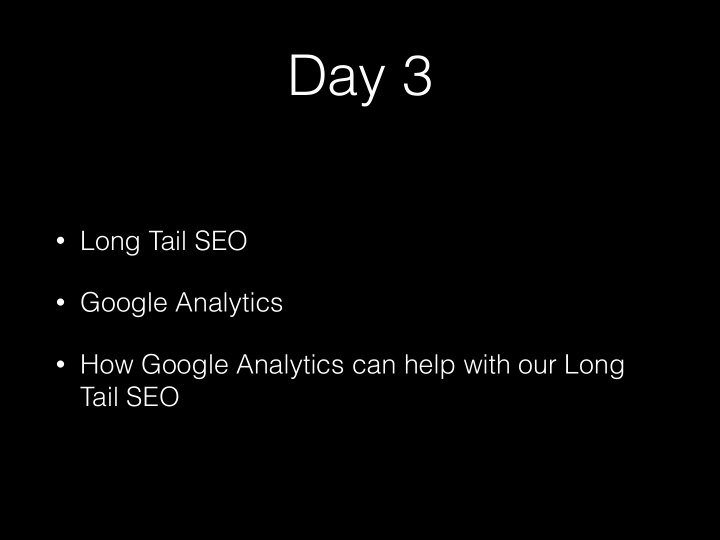



Day 3 • Long Tail SEO • Google Analytics • How Google Analytics can help with our Long Tail SEO
Conversion • Depending on your site, you have a goal in mind for your visitor. • What are you looking for your visitor to do?
What's a conversion for your site? • Are you after sales? • Are you wanting to generate client inquiries? • Do you just want visitors to click and spend time on your site? • Do you want your visitor sign up for your newsletter? • What do you want to measure? • Can you identify the factors that determine the success of your website?
Understanding the Search Demand Curve • Early SEO strategies focused on the Head of the curve • Initially, we didn't have a lot of data • It’s crowded at the top (Head) • Focus is now on the Long Tail
The Long Tail • The remaining 70% • Contains many unique searches. • Comprise the majority of search requests each day.
Rate of Conversions …improves from the long tail search keywords and phrases than from the "popular" head terms.
Finding the Gems • For most, trying to rank high for head and body terms is too expensive and out of reach. • Easier to rank for the less competitive queries (i.e., tail terms). • Conversions are MUCH higher for these tail terms.
How To Find Tail Terms • We don't always know the "tail terms and phrases" • One Suggestion... Let your visitors be your guide.
Google Analytics • Sign up • Site registration • Walk through
Some Questions that GA can answer? • Do you know why people visit your site? • Where are your visitors coming from? • What are they doing on your site? • What technology are they using? • Do you know who your audience is?
Google Analytics
Long Tail Analytics • Visits-to-Query ratio is supposed to be small. • When doing Long Tail SEO work, focus more on the content of your post or article. • ...and though still important, keywords should be second priority (at least in the initial iteration of Long Tail SEO work).
Writing for the Long Tail • The long tail search isn't interested in structure. • What is important: You should have "conversion" goals within your article.
A Rough Guideline • For every 1,000 words in a post, look to draw traffic from about 100 queries.
Writing Long Tail Content • You know the difference. • Make it interesting, funny, engaging for your audience. • Focus on your topic, less on your keywords.
Who Are You Writing For? • With the latest algorithm updates, content is key. • The content should be written for people not the search engines. • Why? People are typing in the search queries not computers.
Recommend
More recommend